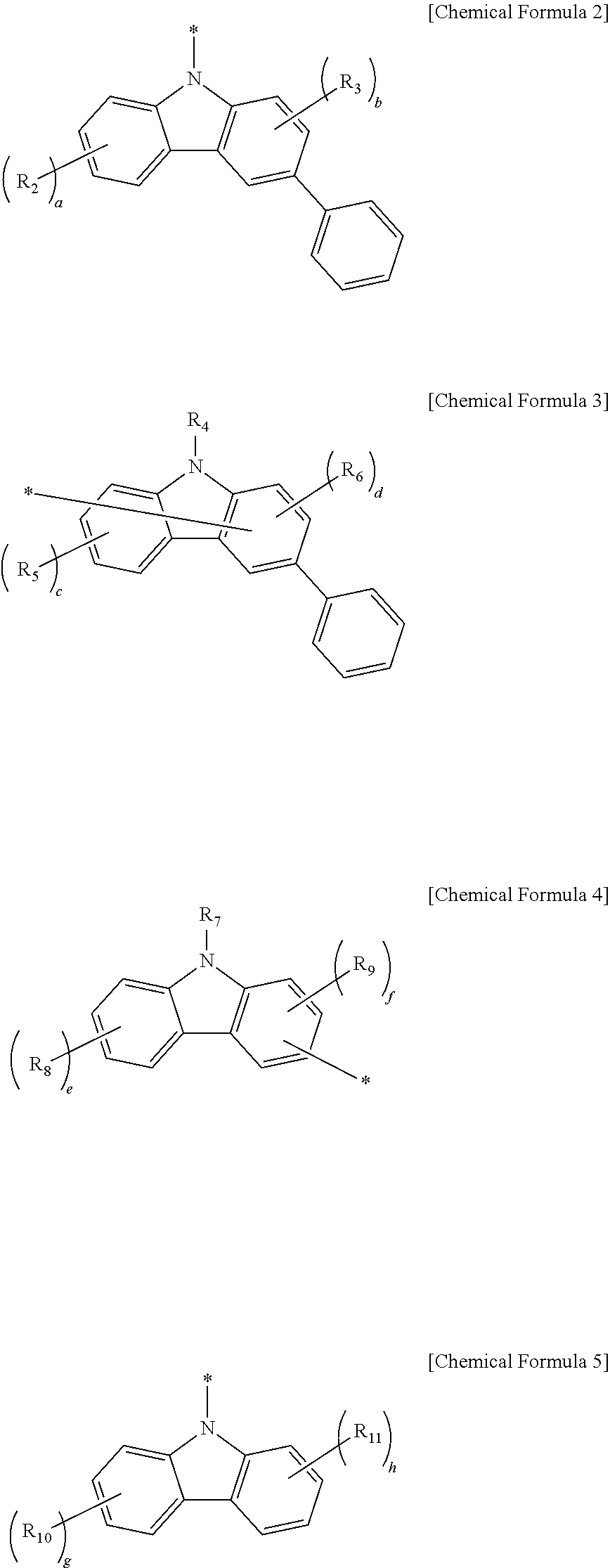Organic compound and organic electroluminescent device using the same
a technology of organic electroluminescent devices and organic compounds, which is applied in the direction of luminescent compositions, organic chemistry, chemistry apparatuses and processes, etc., can solve the problems of poor light emission performance, poor thermal stability, and low glass transition temperature, and achieve excellent light emission performance, excellent electron transport ability, and thermal stability.
- Summary
- Abstract
- Description
- Claims
- Application Information
AI Technical Summary
Benefits of technology
Problems solved by technology
Method used
Image
Examples
fabrication example 1
FABRICATION OF COMPOUND A-1
[0090]
[0091]3-phenyl-9H-carbazole (3 g, 12.3 mmol), 9-(4-chloro-6-phenyl-1,3,5-triazin-2-yl)-9H-carbazole (4.8 g, 13.5 mmol), Pd2(dba)3 (0.6 g, 0.6 mmol), (t-Bu)3P (0.3 g, 1.3 mmol), and NaOt-Bu (2.4 g, 24.6 mmol) were added to Toluene (100 ml), and heated to reflux for 12 hours. After the reaction was completed, the organic layer was extracted by using methylene chloride, MgSO4 was added thereto and the organic layer was filtered. After removing the solvent from the filtered organic layer, the target compound, Compound A-1 (5.5 g, yield 80%), was obtained through column chromatography.
[0092][LCMS]: 564
fabrication example 2
FABRICATION OF COMPOUND A-2
[0093]
[0094]3 -phenyl-9H-carbazole (3 g, 12.3 mmol), 9-(4-chloro-6-phenyl-1,3,5-triazin-2-yl)-3-phenyl-9H-carbazole (5.9 g, 13.5 mmol), Pd2(dba)3 (0.6 g, 0.6 mmol), (t-Bu)3P (0.3 g, 1.3 mmol), and NaOt-Bu (2.4 g, 24.6 mmol) were added to Toluene (100 ml), and heated to reflux for 12 hours. After the reaction was completed, the organic layer was extracted by using methylene chloride, MgSO4 was added thereto and the organic layer was filtered. After removing the solvent from the filtered organic layer, the target compound, Compound A-2 (6.1 g, yield 78%), was obtained through column chromatography.
[0095][LCMS]: 640
fabrication example 3
FABRICATION OF COMPOUND A-3
[0096]
[0097]3 -phenyl-9H-carbazole (3 g, 12.3 mmol), 9-(4-(3 -chlorophenyl)-6-phenyl-1,3,5-triazin-2-yl)-3-phenyl-9H-carbazole (6.9 g, 13.5 mmol), Pd2(dba)3 (0.6 g, 0.6 mmol), (t-Bu)3P (0.3 g, 1.3 mmol), and NaOt-Bu (2.4 g, 24.6 mmol) were added to Toluene (100 ml), and heated to reflux for 12 hours. After the reaction was completed, the organic layer was extracted by using methylene chloride, MgSO4 was added thereto and the organic layer was filtered. After removing the solvent from the filtered organic layer, the target compound, Compound A-3 (6.9 g, yield 79%), was obtained through column chromatography.
[0098][LCMS]: 716
PUM
| Property | Measurement | Unit |
|---|---|---|
| current density | aaaaa | aaaaa |
| Chemical Formula | aaaaa | aaaaa |
| asymmetric structure | aaaaa | aaaaa |
Abstract
Description
Claims
Application Information
 Login to View More
Login to View More - R&D
- Intellectual Property
- Life Sciences
- Materials
- Tech Scout
- Unparalleled Data Quality
- Higher Quality Content
- 60% Fewer Hallucinations
Browse by: Latest US Patents, China's latest patents, Technical Efficacy Thesaurus, Application Domain, Technology Topic, Popular Technical Reports.
© 2025 PatSnap. All rights reserved.Legal|Privacy policy|Modern Slavery Act Transparency Statement|Sitemap|About US| Contact US: help@patsnap.com



